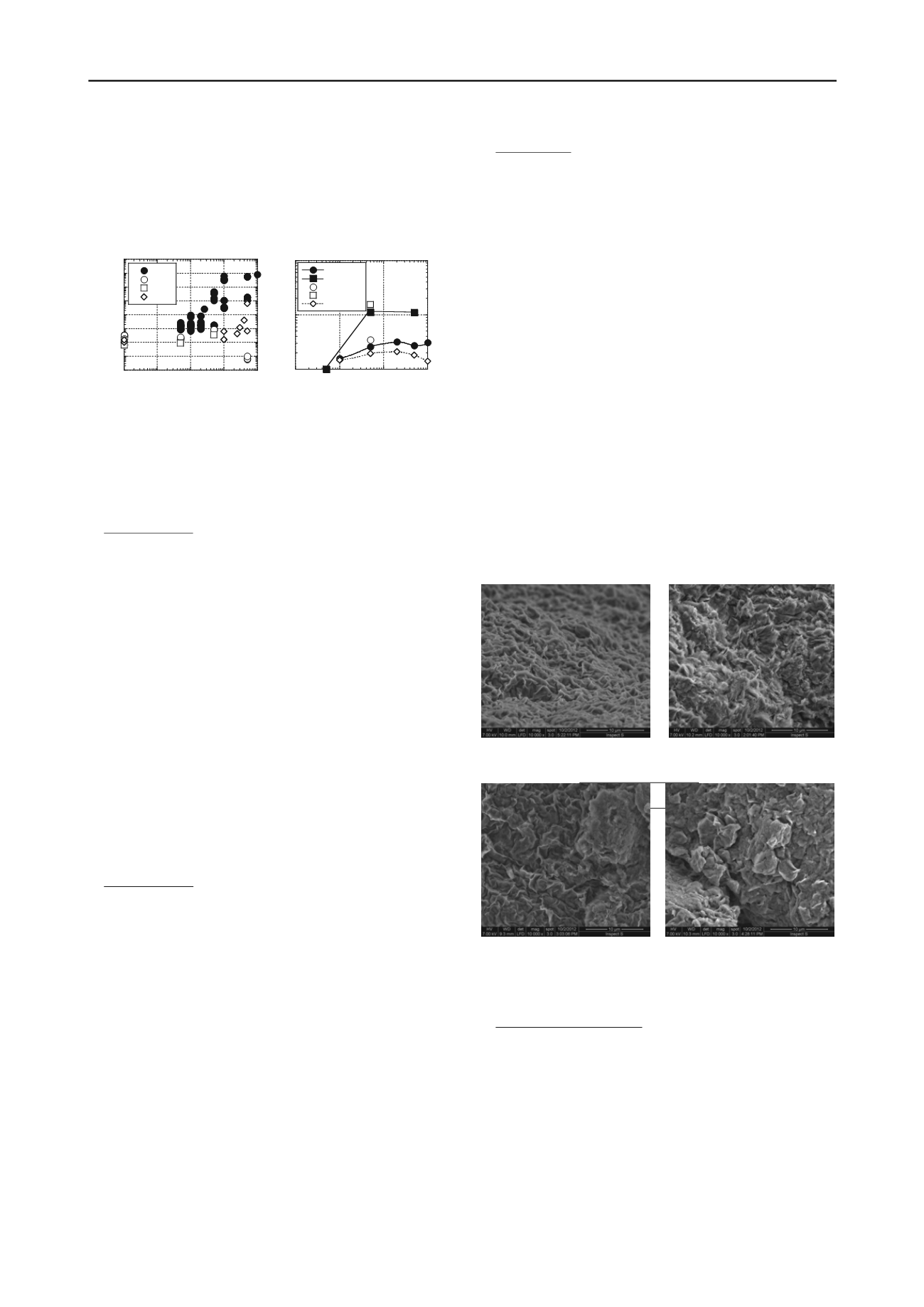
2992
Proceedings of the 18
th
International Conference on Soil Mechanics and Geotechnical Engineering, Paris 2013
bentonite content. The authors indicated that the differences in
behaviour among these novel bentonites illustrated in this paper
highlight the need for further research into the specific
mechanisms affecting the performance of such new materials.
At the same time, the paper shows the potential that such
bentonites can have in addressing aggressive solutes.
10
-13
10
-12
10
-11
10
-10
10
-9
10
-8
10
-7
10
-6
10
-5
0.1
1
10
100 1000
(a)
GCL
BPN
HC2
MSB
Hydraulic Conductivity,
k
w
or
k
c
(m/s)
CaCl
2
Concentration (mM)
1
10
100
1
10
100
1000
(b)
5.7 % NB1
7.1 % NB2
2.4 % BPN
5.5 % BPN
5.6 % MSB
k
c
/
k
w
CaCl
2
Concentration (mM)
10
m
Brianzoni et al
. report the results of a research study aimed
at evaluating and predicting the long term hydraulic
performance of cement bentonite (CB) mixtures used in cut off
walls when in contact with saline solutions (K
2
SO
4
) or acidic
solutions (H
2
SO
4
) at different concentrations. Hydraulic
conductivity tests were conducted for this purpose and lasted in
some cases for 2 year to assess the CB mixtures chemical
compatibility. This paper shows that the saline and acidic
solutions can adversely affect the hydraulic performance of CB
mixtures depending on SO
4
2-
concentration and pH. At
concentration of the order of 25 g/l or more, both solutions
produced an initial decrease in the k value, followed by an
increase and finally an almost constant trend of hydraulic
conductivity with curing time. Swelling and a dense net of
fixtures were detected on both samples after permeation due to
ettringite formation. Sample thickness was found to affect the
response of the CB mixtures when permeated with saline
solutions. The authors indicated that the chemical conditions
adopted in the tests are not expected to occur continuously in
the field if a pumping system is provided so that there is an
advective flow of groundwater and not of pollutant across the
barrier.
Indrawan et al.
present the findings of the work they have
conducted on the effects on the hydraulic conductivity of
compacted clays, commonly used for lining coal seam gas
(CSG) water storage ponds, of moisture conditioning and
permeation with CSG water. Four kaolinite-dominant clays
were mixed with CSG and deionised waters and compacted to
varying compaction degrees at different gravimetric moisture
contents before permeation. Tests were conducted in a rigid
wall permeameter (100 kPa hydraulic loading) and in an
oedometer (100 kPa axial stress). The hydraulic conductivity of
clays moisture-conditioned, compacted and permeated with
saline CSG water (k= 1x10
-11
m/s) was found to be similar to
that of the same clays moisture-conditioned, compacted and
permeated with deionised water. In both CSG and deionised
waters, the compacted clay particles dispersed and the hydraulic
conductivity decreased to a very low value of about 1x10
-11
m/s.
The hydraulic conductivities measured using a compaction
mould permeameter were found to be comparable to, and a little
higher than, those calculated from oedometer test data for the
same compacted clays. The authors concluded that the clays
investigated would be suitable as a liner for a CSG water
storage pond.
Hanson et al.
present the results of a laboratory investigation
aimed at determining the moisture-suction relationships of
geosynthetic clay liners (GCLs) under as-received conditions
(moisture contents in the range of 14-27%) and subsequent to
wet-dry cycles (20 cycles at 50% moisture content). Tests were
conducted on three types of needle punched GCLs which
contained granular bentonite. Two of the GCLs were of the
conventional types whereas the third GCL was of a multi-
component type (i.e. the carrier geotextile was composed of a
non woven geotextile and a geofilm). Differences were
observed between the conventional and multi-component GCLs
and between the as-received and wet-dry cycled GCLs. The air
entry suction value for the multi-component GCL was found to
be lower than that for the conventional GCLs for the drying
branches of the moisture suction curves and higher for the
wetting branches of the curves. The residual suction value for
the multi-component GCL was found to be higher than the
residual suction values for the other two GCLs. The extent of
hysteresis decreased and the differences between drying and
wetting curves reduced for the wet-dry cycled specimens
compared to the as-received specimens. Macro- and micro-
structural variations determined through grain size distribution
and SEM analyses (Fig. 3) indicated increasing void sizes and
non-uniformity in fabric due to wet-dry cycling, supporting the
observations made for variations in moisture-suction response.
Figure 2. Permeation results for
sand-bentonite backfills: ratio of
hydraulic conductivity to CaCl
2
solution,
k
c
, relative to hydraulic
conductivity to water
k
w
as a
function
of
CaCl
2
concentration
(Bohnhoff et al., 2013)
Figure 1 Hydraulic conductivity
of bentonite specimens as a
function
of
(a)
CaCl
2
concentration in the permeant
liquid (Bohnhoff et all., 2013)
a) 1 cycle (fully dispersed) b) 10 cycles
c) 20 cycles (DI water) d) 20 cycles (tap water)
Figure 3. SEM images of bentonite from GCL specimens (Hanson et al.
2013)
Rayhani and Sarabadani
describe a laboratory simulation
study undertaken to quantify the hydration progress of
Geosynthetic Clay Liners (GCLs) from underlying subsoils
under simulated landfill conditions, before and after having
been covered by municipal solid waste. GCL hydration was
shown to be highly dependent on GCL manufacturing
techniques, grain size distribution and initial moisture content of
the subsoil. In particular, the difference in suctions between the
GCLs and the type of subsoils was found to be an important
factor governing the hydration process. The thermally treated,
scrim-reinforced GCL demonstrated higher rate and degree of
hydration compared to the other GCL products tested under
similar conditions mainly due to the better anchorage of the
connection layer against swelling of bentonite upon hydration.


